
Growing economic relations between China and the Association of Southeast Asian Nations (ASEAN), plus with the stabilized situation of the South China Sea, are crucial to securing long-term peace and shared prosperity in the region.
ASEAN now China's no.2 trade partner
The 10-member ASEAN became China's second-largest trading partner in the first half of 2019, overtaking the United States for the first time since 1997.
China's customs data showed that China's trade with ASEAN rose 10.5 percent to 1.98 trillion yuan (288 billion U.S. dollars) in the first half of the year, while trade with the U.S. dropped 9 percent to 1.75 trillion yuan (254 billion U.S. dollars).
China has been ASEAN's largest trading partner for nine consecutive years, having become a huge market for the regional bloc's member countries.

Infographic by CGTN's Yin Yating
For example, the planting of durians has been picking up steam across Malaysia in recent years owing to increasing demand from China, the world's largest market for this thorny and pungent "king of fruits."
In 2018, China ended Japan's 30-year streak to become the biggest foreign market of Philippine bananas, buying a total of 1.165 million tons, 56 percent up from 2017, according to the Philippine Statistics Authority.
Over the past two years, China has also become the largest Cambodian rice importer with other agricultural products, such as cassava, maize and banana also being shipped in bulk, said Cambodia's Ministry of Commerce Undersecretary of State and Spokesman Seang Thay.
The soaring exports of Malaysian durian, Philippine fruits and Cambodian rice to China are just a glimpse of the opportunities provided by a more open, robust Chinese market when the world trade is predicted to continue facing strong headwinds in 2019 and 2020 after growing more slowly than expected last year.
BRI boosts connectivity between China, ASEAN markets
Speaking at the promotion conference of the 16th China-ASEAN Expo (CAEXPO), Sharimahton Mat Saleh, deputy chief executive officer of the Malaysian External Trade Development Corporation (MATRADE) said businesses between China and ASEAN will benefit from the China-proposed Belt and Road Initiative (BRI).
"The Chinese government had earmarked CAEXPO as one of the key initiatives under the ambitious Belt and Road Initiative. This is reflected by the CAEXPO 2019 theme - Building Belt and Road Routes, Realising Our Vision for a Community of Shared Future," the officer said on April 24, 2019.
"CAEXPO is a strategic entry platform for Malaysian companies to tap into not only China but the ASEAN markets too."
'Smooth progress' on COC in South China Sea
Regarding a Code of Conduct (COC) in the South China Sea, China is of the view that "smooth progress" in consultations with ASEAN has been accomplished, a Chinese foreign ministry spokesperson said in March.
Back in 2018, Chinese leaders had proposed completing the consultations for a COC in the South China Sea within three years, which met with positive responses from ASEAN countries.

Infographic by CGTN's Liu Shaozhen
'Where there are threats, there are defenses'
However, in recent years, some countries outside the region have come to the South China Sea to flex their muscles, in the name of "freedom of navigation".
Chinese State Councilor and Defense Minister Wei Fenghe thus reiterated in June that China's construction of its South China Sea islands and reefs is its legitimate right and is purely defensive.
"The large-scale force projection and offensive operations in the region are the most serious destabilizing and uncertain factors in the South China Sea," he said.
If there is chaos in the South China Sea, the regional countries are the ones who will bear the brunt, and China and ASEAN countries have made progress in negotiating the code in the South China Sea, he added.
"Where there are threats, there are defenses. In the face of heavily armed warships and military aircraft, how can we stay impervious and not build some defense facilities?"
China urges U.S. to stop irresponsible behavior on South China Sea issue
Recently, Beijing hit back at a U.S. statement that it is concerned about reports of China's interference with oil and gas activities in the South China Sea, urging the U.S. side to stop stirring up trouble with regard to the issue of the South China Sea and to respect the regional countries' efforts to resolve disputes through dialogue.
In the statement, the State Department also cited Secretary of State Michael Pompeo's comments earlier this year when he said China has blocked the development in the South China Sea through coercive means. U.S. National Security Adviser John Bolton also said China threatens peace and stability in the Indo-Pacific region by adopting coercive behavior.
"The current situation in the South China Sea is generally stable," Foreign Ministry spokesperson Geng Shuang told a press briefing Monday, noting that under the framework of fully and effectively implementing the Declaration on the Conduct of Parties (DOC) in the South China Sea, China and ASEAN countries are actively promoting pragmatic maritime cooperation and consultation on COC in the South China Sea to effectively safeguard peace and stability in the region.
"The remarks made by Mr. Pompeo and Mr. Bolton are completely void of the facts and are defamatory to the aspirations and efforts of China and ASEAN countries to maintain peace and stability in the South China Sea and properly manage disputes. Countries and people in this region will not be fooled," he added.
(With input from Xinhua)

Copyright © 2018 CGTN. Beijing ICP prepared NO.16065310-3
Copyright © 2018 CGTN. Beijing ICP prepared NO.16065310-3